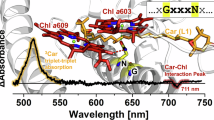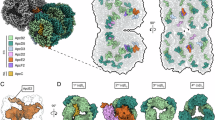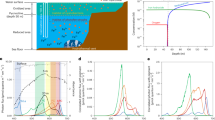Abstract
THE transmission of light in coastal waters is such that penetration is greatest in the blue-green and least in the red region of the visible spectrum1. This has led to the view that the phycobilins, accessory pigments that give rise to the characteristic colour of red algae, are responsible for photosynthesis by these plants because, unlike chlorophyll, the pigments readily absorb blue-green light2. Evidence in favour of this theory of complementary chromatic adaptation has been obtained by Haxo and Blinks from experiments in which the action spectra of several marine, red algae were found to show a fair correlation with the absorption curves of phycoerythrin and phycocyanin3.
This is a preview of subscription content, access via your institution
Access options
Subscribe to this journal
Receive 51 print issues and online access
$199.00 per year
only $3.90 per issue
Buy this article
- Purchase on SpringerLink
- Instant access to full article PDF
Prices may be subject to local taxes which are calculated during checkout
Similar content being viewed by others
References
Atkins, W. R. G., Trans. Illum. Eng. Soc., 10, No. 7 (1945).
Engelmann, T. W., Botan. Z., 41, 1 (1883).
Haxo, F. T., and Blinks, L. R., J. Gen. Physiol., 33, 389 (1950).
Boney, A. D., and Corner, E. D. S., J. Mar. Biol. Assoc. U.K., 38, 267 (1959).
Føyn, B., Arch. Protistenk., 83, 1 (1934).
Boney, A. D., Corner, E. D. S., and Sparrow, B. W. P., Biochem. Pharmacol., 2, 37 (1959).
Author information
Authors and Affiliations
Rights and permissions
About this article
Cite this article
BONEY, A., CORNER, E. A Possible Function of Phycoerythrin in Intertidal Red Algae. Nature 188, 1042–1043 (1960). https://doi.org/10.1038/1881042a0
Issue date:
DOI: https://doi.org/10.1038/1881042a0
This article is cited by
-
Abnormal Growth of Sporelings of a Marine Red Alga Induced by Thalidomide
Nature (1963)
-
Blue-Green Algae: Growth
Nature (1961)



